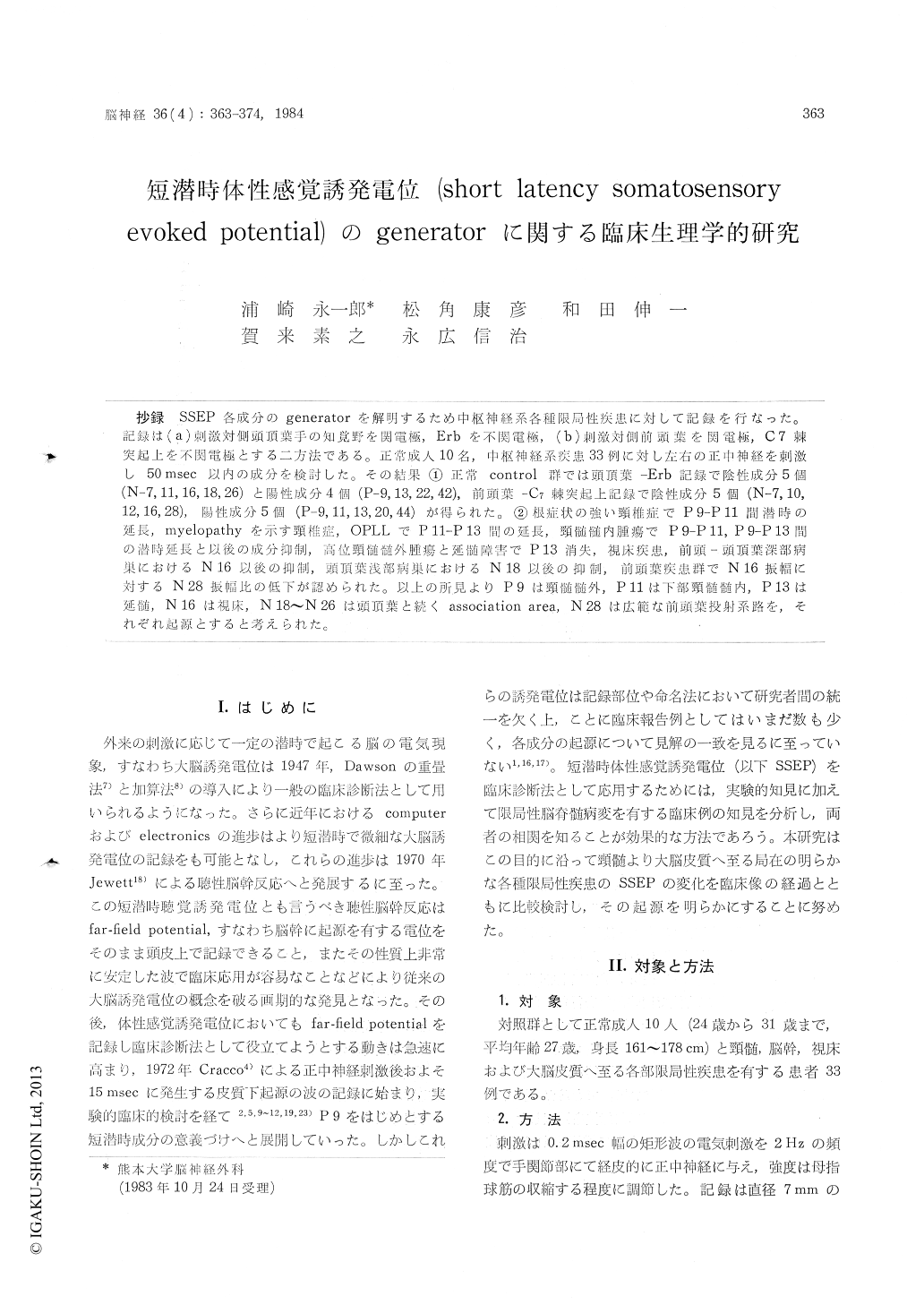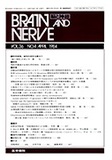Japanese
English
- 有料閲覧
- Abstract 文献概要
- 1ページ目 Look Inside
抄録 SSEP各成分のgeneratorを解明するため中枢神経系各極限局性疾患に対して記録を行なった。記録は(a)刺激対側頭頂葉手の知覚野を関電極,Erbを不関電極,(b)刺激対側前頭葉を関電極,C7棘突起上を不関電極とする二方法である。正常成人10名,中枢神経系疾患33例に対し左右の正中神経を刺激し50msec以内の成分を検討した。その結果①正常control群では頭頂葉—Erb記録で陰性成分5個(N−7,11,16,18,26)と陽性成分4個(P−9,13,22,42),前頭葉—C7棘突起上記録で陰性成分5個(N−7,10,12,16,28),陽性成分5個(P−9,11,13,20,44)が得られた。②根症状の強い頸椎症でP9—P11間潜時の延長,myelopathyを示す頸椎症,OPLLでP11—P13間の延長,頸髄髄内腫瘍でP9—P11,P9—P13間の潜時延長と以後の成分抑制,高位頸髄髄外腫瘍と延髄障害でP13消失,視床疾患,前頭—頭頂葉深部病巣におけるN16以後の抑制,頭頂葉浅部病巣におけるN18以後の抑制,前頭葉疾患群でN16振幅に対するN28振幅比の低下が認められた。以上の所見よりP9は頸髄髄外,P11は下部頸髄髄内,P13は延髄,N16は視床,N18〜N26は頭頂葉と続くassociation area,N28は広範な前頭葉投射系路を,それぞれ起源とすると考えられた。
The purpose of this paper is to locate the gene-rators of each wave component in the short latency somatosensory evoked potential (SSEP), by means of cumulative analysis of the SSEP obtained from various localized lesions in the upper cervical cord through brain stem and cerebral subcortical structures. Since there are considerable inconsis-tency of naming each component in the literature, SSEP to median nerve stimulation of 10 normal subjects were examined by two different record-ings, i. e. recording from an electrode at the parietal scalp with a reference electrode on Erb's point (Par.-Erb), and the other at the frontal scalp with a reference electrode on Cv7 (Fro.-Cv7), and the SSEP was carefully studied. In normal subjects, the SSEP by Par.-Erb lead yielded 5 ne-gative components (N7, N11, N16, N18 & N26) and 4 positive components (P 9, P 13, P 22 & P 42), while by Fro.-Cv75 negative components (N7, N10, N12, N16 & N28) and 5 positive compo-nents (P9, P11, P13, P20 & P44).
Thirty three patients were subjected to analyse the influence of localized lesions to each compo-nent of the SSEP and the recording was evaluated in regard to (a) identification of each component, (b) latency of each component and inter-peak la-tency difference exceeding 2 SD, and (c) over 50% asymmetry and laterality of the amplitude. Cer-vical spondylotic myelopathy, high cervical cord tumor, tonsillar herniation, pontine infarct and he-morrhage, circumscribed thalamic lesion, and vas-cular lesion of centrum semiovale were carefully examined with CT scan and the findings were compared with neurological findings periodically. SSEP was taken repeatedly, especially before and after operative intervention, and alteration of the component was referred to the clinical progress of the lesion.
In conclusion, results obtained from our present observation indicated that P9 was the extramedul-lary projection, P11 was intramedullary origin ofthe lower cervical cord, P13 was medulla oblon-gata origin and P13-N16 was projection from medulla oblongata to thalamus. N16-N18 and N26 were considered projection from thalamus to hand area of the parietal lobe with some associa-tion area and N28 had the generator widelybased on frontal projection system. These findings appeared to be quite useful for topographic diag-nosis and functional evaluation of the lesions in central nervous system.

Copyright © 1984, Igaku-Shoin Ltd. All rights reserved.


